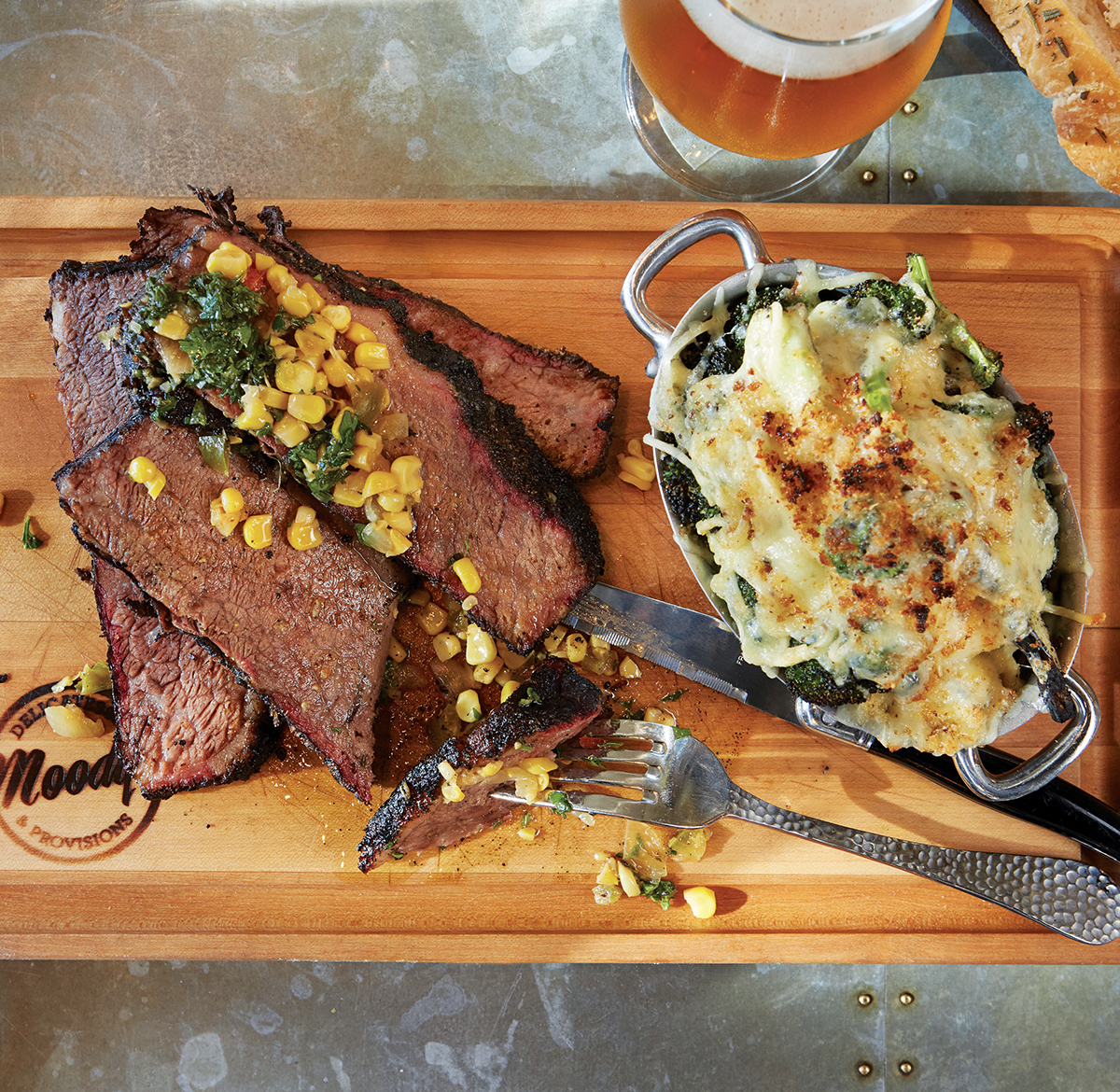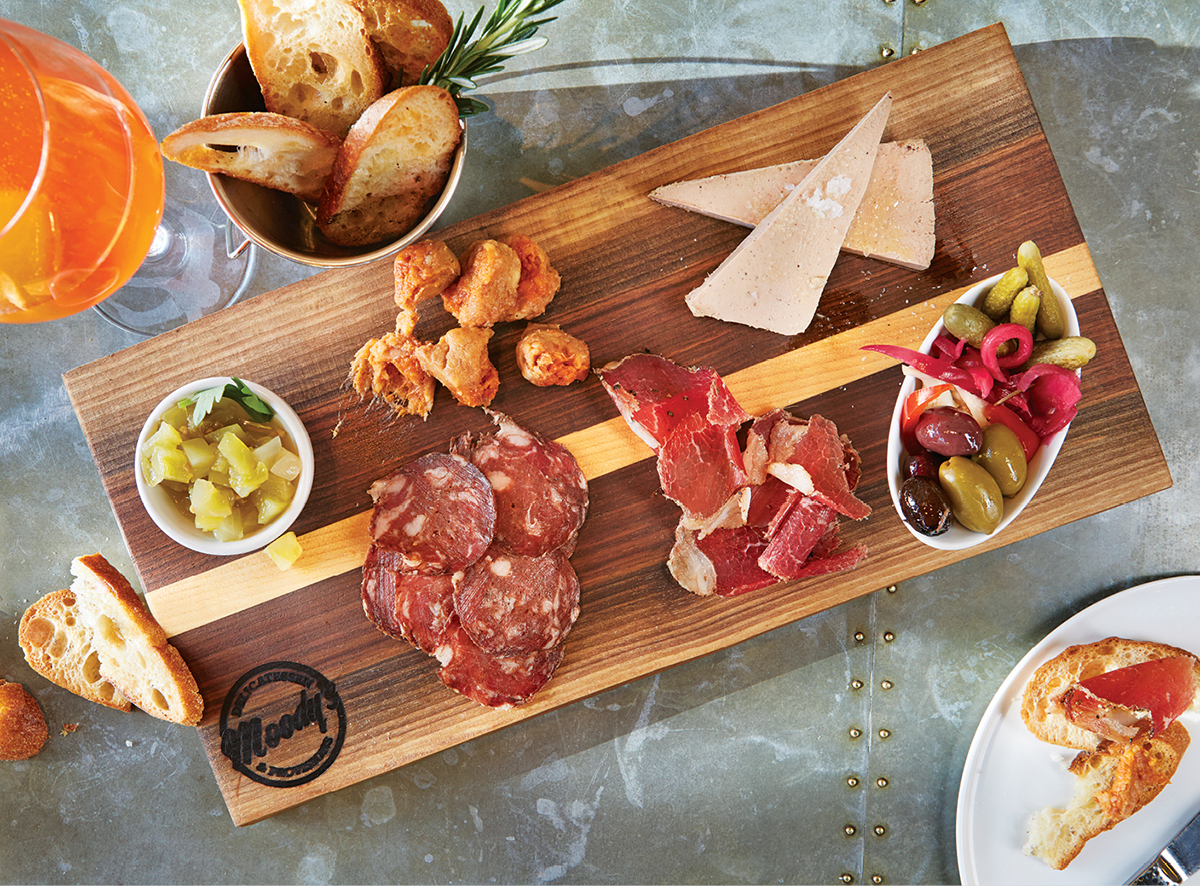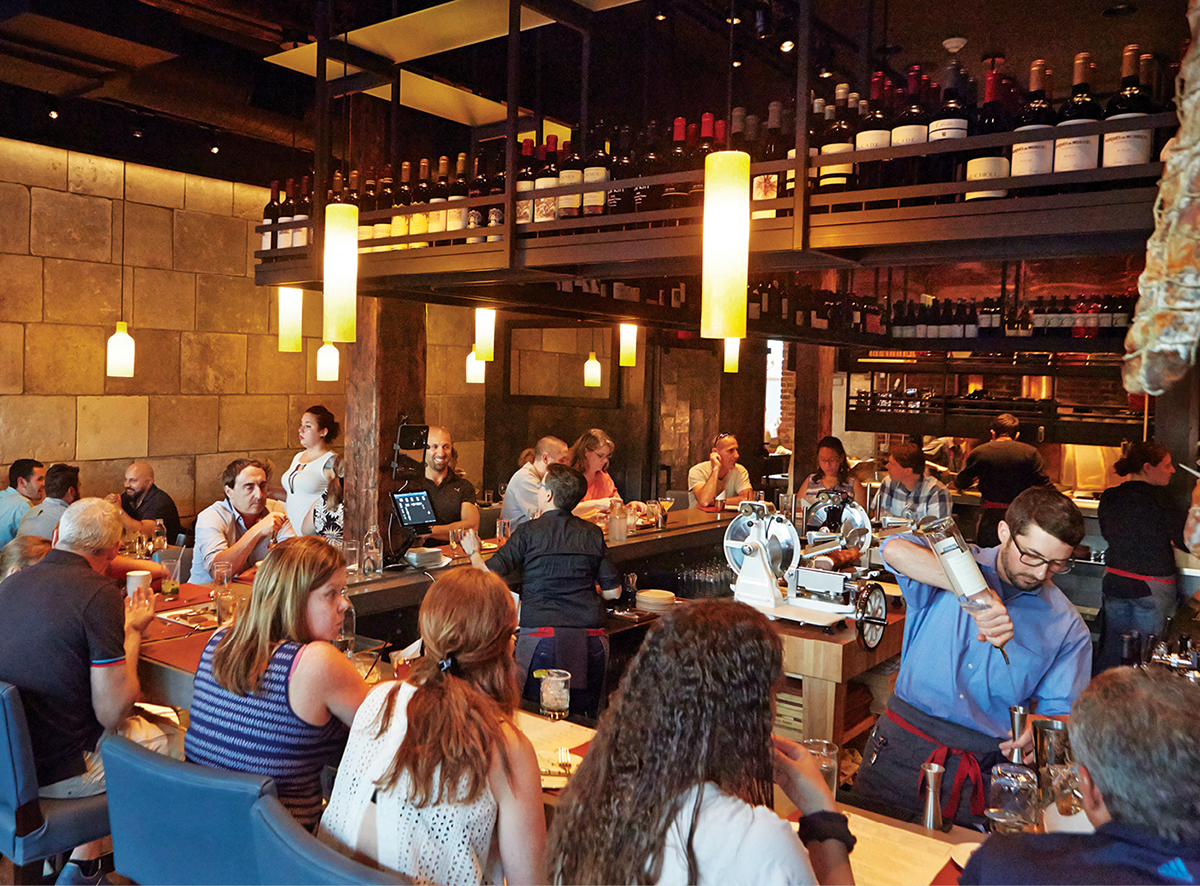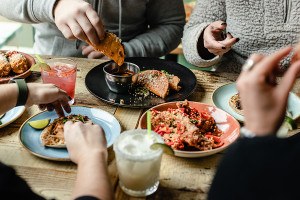Restaurant Review: The Backroom at Moody’s

Smoked Wagyu brisket served with broccoli gratin and chimichurri. / Photograph by Nina Gallant
A restaurant built on sausages and cured meats? Why not? The Backroom at Moody’s Delicatessen & Provisions has an ambitious chef, Joshua Smith, who paid his dues in well-known kitchens—Tico and the Four Seasons—and knows how to produce and expedite a classic menu. But his real cooking passion, which he started learning at the age of 19 from French chef mentors at Dean & DeLuca in North Carolina, is making terrines, salami, and sausages. Two years ago he put “every penny” he had into opening Moody’s, a delicatessen in downtown Waltham selling an unusually wide range of cured meats—a list of 89 items, Smith says, many of them collaborations with, and for, local chefs like Matt Jennings, of Townsman.
Then one of Smith’s regular customers became a very, very generous patron, offering to help build out a full-scale restaurant behind the deli. In April, the Backroom at Moody’s, a 50-seat restaurant and wine bar, opened with a long and ambitious menu.
You might not be able to detect every penny of the costly construction, but you’ll see plenty of it in the big, somewhat clunky, cube-shaped room, which you enter from the old-world deli. The far wall of the dining room is made of giant gray limestone blocks originally from a French abbey (evidently New England’s abundant granite and limestone weren’t special enough); the ceiling features centuries-old beams purchased in New Hampshire; and in the kitchen, new Chefs’ Toys ovens sit alongside more-primitive appliances like a copper-domed wood-fired oven. Even the accoutrements at the table are far more expensive than usual: Sides are served on impressively heavy metal dishes that run upward of $60 apiece, and the pewter pepper mills are Peugeot, the Rolls-Royce of the condiment trade. The servers will tell you all of this with rightful pride as they impressively rattle off the details of the 15 charcuterie items and 10 cheeses available for plates and boards, plus the two dozen or so entries on the rest of the menu.
Are the meats worth a trip to Waltham? A number of them, for sure. Smith is practicing a culinary art that’s been absent in Boston beyond a few North End shops. His charcuterie (starting at $6 each) has the inventiveness and whimsy you’d find at a sushi bar, while adhering to a fairly formal structure. And Smith bucks convention by using a wide range of citrus and spices. It’s clear that he and his colleagues are aiming to bring diners (and chefs) new ideas.

A charcuterie board with tartufo salami, chicken-liver mousse, and other bites. / Photograph by Nina Gallant
Many dishes succeed because of Smith’s light touch with flavorings that, used in excess, can easily go awry. I was sure the tartufo salami would taste of the usual lurid, synthesized white-truffle powder but was pleasantly surprised by a subtly salty, earthy undertone in the otherwise impeccably clean-flavored salami. Similarly, Jennings had requested a sausage flavored with nori, tahini, Sichuan pepper, orange, and…maple syrup. “You sure that’s what you want?” Smith asked him. Two months later Smith delivered a maple-togarashi sausage, and it’s a good thing Jennings let him sell it on the Backroom menu. It was barely—not obtrusively—sweet, with only a bit of the gentle, precise bite of the Japanese spice mixture. Mole salami was another highlight: Ghost peppers, nuts, and cocoa powder all lend themselves to sausage, the interplay of sweet and hot making for a happy exchange.
Not all seasonings are used with such a judicious touch. Lebanon bologna, a Pennsylvania Dutch beef summer sausage, had a pumpkin-pie sweetness because of the amount of cinnamon Smith added. Porcini salami was all salt, with some musty white pepper. For a return to form, try the half-liver, half-pork-fat chicken-liver mousse—a kind of after-the-fact foie gras that had a similar silken texture from the kitchen’s elaborate puréeing and sieving of the mixture.
But then comes the rest of the menu. The farther you roam from Smith’s long-honed charcuterie (20 years of practice and experimentation, he told me), the clearer it becomes that the chef’s lavishly outfitted room might have been a case of too much, too soon. Dishes can feel haphazard, with too many elements and out-of-whack seasoning. A salami crumble atop cavatelli tasted musty ($14); someone had a heavy hand with a caramelized-shallot vinaigrette on the frisée salad with duck confit ($15); and the underbaked flatbreads were laden with as much meat and cheese as a deep-dish pizza, an unfortunate misuse of the Backroom’s beautiful copper-domed oven.
The simplest courses are often the best, particularly the fish of the day ($29), which was a fine, firm, flaky striped bass. Served with buttery braised fennel, it somehow tasted meatier than some of the meat-heavy courses. With the bass, beef lardons acted as a neat alternative to bacon, and the fennel was an enriching accompaniment. Small touches also registered: A side of grilled asparagus ($8) was full of flavor, including a béarnaise made in another fancy machine Smith has fallen in love with: a Thermomix that simultaneously blends and cooks.

The elaborate space features limestone bricks sourced from a French abbey. / Photograph by Nina Gallant
The triumphant main course, smoked Wagyu brisket ($36), involves a gadget that by now is almost old-fashioned: a sous-vide machine that slow-cooks meat, in this case, brisket for 48 hours. Imported directly from a ranch in Australia, the beef was extraordinary, perhaps because Smith first smokes it, rubs it with porcini powder, and chars it before serving. It was fatty, rich, and lush. A big rib-eye ($68) and a skirt steak ($28) from the same ranch were just fine; a rib-eye skewer with the same chimichurri as the brisket featured terrific, moist squares of meat, and was a bargain at $10. But it’s hard to match that brisket.
Desserts make use of even more gadgets, particularly ice creams (a selection of three for $9) individually made in a Pacojet, with the bases cooked in the Thermomix. They were quirky, mild-flavored, honest, and good, particularly a custardy Valrhona chocolate. The best dessert was the panna cotta ($11) with a dispensable banana- and-peanut-butter crumble. I didn’t ask what machine it was made in—all I needed to remember was that it was startlingly delicate.
Ultimately, the Backroom at Moody’s feels like it took on too much in too little time. It’s fun to be there—people are having a good time, and the encouraging staffers want them to. (It’s also loud: None of that impressive budget went to sound control.) But if you start with select charcuterie, don’t skimp on the smoked Wagyu brisket, and finish with the panna cotta, you’ll surely return—and with luck find a streamlined menu highlighting Smith’s meaty strengths.
MENU HIGHLIGHTS
Chicken-liver mousse • $6
Smoked Wagyu brisket • $36
Fish of the day • $29
Panna cotta • $11
468 Moody St., Waltham, 781-216-8732, moodyswaltham.com.
Critic Corby Kummer—an editor at the Atlantic and author of The Pleasures of Slow Food—has been reviewing Greater Boston’s top restaurants in our pages since 1997.


